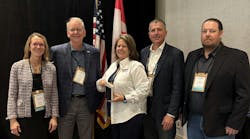Out Of The Box
In a time of tight regulations and even tighter budgets, utilities and engineers need to look to innovative ways to fix our aging infrastructure. Here, SWS Managing Editor Mary Beth Nevulis speaks with John Wilson, owner of J.W. & Associates USA, an independent marketing representative for contractors and materials, about ways to repair underground storm water structures without actually going underground.
Mary Beth Nevulis: Can you explain what your company does?
John Wilson: The focus of our services is to achieve long-term structural solutions for compromised storm water infrastructure. The procedure methodology is exclusively trenchless.By avoiding excavation and the heavy construction impact involved with system replacement, you minimize costs while gaining a comparable new service life. The task requires expertise and the work often is performed under restrained conditions; however, the impact above ground remains light. Liability becomes a factor the moment you disturb utilities. The savings from not disrupting local traffic adds up to found money, allowing precious resources to reach additional high-priority projects.
Nevulis: What sets your approach apart from other rehabilitation methods?
Wilson: In terms of storm water pipe and culvert rehabilitation, methods for relining pipe have been around a quarter of a century now. I am convinced the best value for a true long-term solution that provides structural renewal is achieved by using high-strength cements. It all starts with high quality materials and a qualified contractor who places emphasis on thorough preparation and application. The process is essentially cast-in-place cement construction. With box culverts, you might refer to the method as “build-in-place.”
Nevulis: What are the benefits of using high-strength cement?
Wilson: In addition to the U.S. Army Corp of Engineers rating concrete as having a service life of 70 to 100 years, hydraulic capacity is a big consideration. The loss of pipe capacity can be critical and compared with slip-lining, for example, our cement spray application presents minimal change to interior volume. In most cases, just one to two inches of cement build will exceed potential load-bearing capacity.
Nevulis: What applications are best suited for this technology?
Wilson: The rehabilitation of manholes using high-strength cements has been around for a long time. The process in horizontal application is ideal for round or elliptical shape culverts. Whether the structure is reinforced concrete pipe or corrugated metal pipe, it merely serves as the casting form in the process. Recently I participated in a design-build project for Florida Department of Transportation [DOT]. The challenge was developing an in-ground solution to fortify a badly compromised, more than 90-year-old pre-cast box culvert that was located beneath a one-way corridor in a high-traffic downtown district. Excavation and replacement was not an option. The solution was to build a box within a box—an application that will see frequent use in the years to come. Essentially, due to the load dynamics, engineering design calculations resulted in a procedure that combined our high-strength cement with reinforcement steel. This solution has attracted enormous interest from other DOT districts.
Nevulis: What kinds of challenges do you face?
Wilson: I suppose the single biggest challenge is educating government agencies about the benefits we can provide. The condition of infrastructure in the U.S. is wide open for innovative procedures. The time is now for effective solutions that save money, provide fast-track restoration, and have low impact on the nation’s motorists and high-yield returns from budget appropriations.
John Wilson is owner of J. W. & Associates USA, an independent marketing representative for contractors and materials. Wilson can be reached at [email protected].
Download: Here

